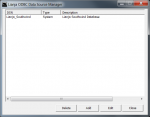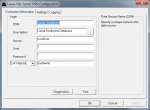Lianja ODBC Manager on Windows
Contents
See Also
Lianja SQL Server Manager, SQL System Tables
The Lianja ODBC Manager
The Lianja ODBC Manager allows you to create, edit and delete Lianja ODBC data sources. It can be accessed from its desktop shortcut or from the Windows Start Menu under Lianja.
User Account Control
If you have User Account Control enabled, please click Yes on the UAC dialog displayed when you run the Lianja ODBC Manager. On Windows XP, please run the Lianja ODBC Manager as the Administrator.
Lianja ODBC Data Source Manager
The Lianja ODBC Data Source Manager displays your currently configured data sources:
- Data Source Name (DSN)
- Type (System, User, File)
- Description
The buttons give you access to the following operations:
| Operation | Description |
|---|---|
| Delete | Delete the currently selected DSN. |
| Add | Configure a new DSN. |
| Edit | Configure the currently selected DSN. |
| Close | Close the Lianja ODBC Manager. |
Choosing either of the Configure operations displays the Lianja DSN Configuration dialog.
Lianja DSN Configuration
The Connection Information tab contains all the standard configuration details. The optional Settings and Logging tabs are for optional settings.
Connection Information
The following settings can be configured:
| Setting | Description |
|---|---|
| DSN | Unique data source name. |
| Description | Description of data source. |
| Server | Host name or IP address of Lianja SQL Server. |
| User | User name of valid account on the server. For the local server, this can be '?'. |
| Password | Password for the above account on the server. For the local server, this can be '?'. |
| DATABASE or DIRECTORY | DATABASE: The name of the database on the server. DIRECTORY: The directory path where free tables are stored. |
Note: The Lianja SQL Server (includes Lianja ODBC Driver) and Lianja ODBC Driver product distributions come with a fully-configured DSN to the southwind sample database on the local machine.
Background Scripts
The Background Scripts tab allows for the creation, modification and configuration of background service scripts. Background service scripts can be used to perform data transformation, data synchronization or any other custom operation on your data that you require in your Apps.
Background service scripts run with no UI. They are primarily used to perform data collection tasks or batch job tasks such as checking for new or updated data and emailing out notifications to Lianja users. Typically a background service will sleep for a period of time and then repeat its work. Background service scripts have the standard program extensions of prg/dbo and reside in the services sub-folder of the Lianja SQL Server root (see Settings above for default folders). Whenever the Lianja SQL Server service is started, any programs in the services folder with their Startup Mode set to Automatic will be run.
| Section | Item | Description |
|---|---|---|
| Scripts | Script | Script name |
| Status | Service status: Stopped, Started | |
| Startup Mode | Service startup mode: Manual, Automatic. | |
| Buttons | New... | Create a new script. |
| Edit... | Edit the selected script. | |
| Delete | Delete the selected script. | |
| Mode (Automatic or Manual) | Toggle the startup mode of the selected script between Automatic and Manual. | |
| Refresh | Refreshes the display | |
| Status (Started or Stopped) | Toggle the status of the selected script between Started and Stopped. |
Template Background Script
//============================================================================ // // FILE : example.prg // // PURPOSE : Example code for a Lianja background service script on Windows. // //---------------------------------------------------------------------------- // // Background service scripts are called with two parameters: // // script : full path name of the script // action : Either "start", "stop" or "restart" // //----------------------------------------------------------------------------- // // Functions // // start() : Called when the service is started. Creates a // filename.active and processes all actions while this // file exists. // // stop() : Removes the filename.active file so the service will // stop when it next wakes up to do any work. // // doWork() : This is the place to add your main processing code. // //============================================================================ //----------------------------------------------------------------------------- // declare global variables //----------------------------------------------------------------------------- public p_active_file public p_error_file public p_sleep_seconds //----------------------------------------------------------------------------- // Start action //----------------------------------------------------------------------------- function start( ) // Check to see if a ".error" file already exists for this script // and delete it if it does. if file(p_error_file) erase &p_error_file if file(p_active_file) erase &p_active_file endif endif // Check to see if a ".active" file already exists for this script // and return if its already active if file(p_active_file) return .f. endif // Create the ".active" file for this script fp = fcreate(p_active_file) if ferror() = -1 return .f. else fclose(fp) endif // process any work for this script do while file(p_active_file) sleep p_sleep_seconds doWork() enddo return .t. //----------------------------------------------------------------------------- // Stop action //----------------------------------------------------------------------------- function stop( ) // Erase active file so service will stop erase &p_active_file // return result if file(p_active_file) rc = .f. else rc = .t. endif return rc //----------------------------------------------------------------------------- // error handler //----------------------------------------------------------------------------- function errorHandler( ) on error save error to &p_error_file stop() return //----------------------------------------------------------------------------- // function to handle the requested script action //----------------------------------------------------------------------------- function handle_action(action, sleepTime, scriptName) // Setup exit handler on finish stop() // Setup error handler on error errorHandler() // by convention we use files prefixed by the script name and postfixed with // .active and .error to keep us informed of the script execution status p_active_file = lower(basename(left(scriptName, at(".", scriptName) -1)+".active")) p_error_file = lower(basename(left(scriptName, at(".", scriptName) -1)+".error")) p_sleep_seconds = sleepTime // Change the default directory as thats where the .active status file is written set default to "C:\Lianja\sqlserver\services" // handle the specified action do case // Start service case upper(action) = "START" result = start() // Stop service case upper(action) = "STOP" result = stop() // Restart service case upper(action) = "RESTART" stop() result = start() // Unknown command otherwise result = .f. endcase return result //----------------------------------------------------------------------------- // this is the function that will be executed by this script to handle its work //----------------------------------------------------------------------------- function doWork( ) // TODO: add your own custom code here return //----------------------------------------------------------------------------- // Call the Lianja background service script action handler //----------------------------------------------------------------------------- return (handle_action(_para1, 10, procname()))
Windows ODBC Administrator
Lianja ODBC data sources can also be managed using the Windows ODBC Administrator. Please note that on 64 bit systems, the 32 bit ODBC Administrator should be used (%windir%\SysWOW64\odbcad32.exe).


